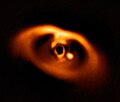| Observation data Epoch J2000 Equinox J2000 | |
|---|---|
| Constellation | Pictor [1] |
| Right ascension | 06h 08m 31.968s [2] |
| Declination | −59° 32′ 28.08″ [2] |
| Apparent magnitude (V) | 11.72 [3] |
| Characteristics | |
| Evolutionary stage | main sequence [4] |
| Spectral type | F8 / M [5] |
| Variable type | eclipsing [5] |
| Astrometry | |
| Radial velocity (Rv) | 23.56±5.34 [2] km/s |
| Proper motion (μ) | RA: −12.057 [2] mas/yr Dec.: +34.513 [2] mas/yr |
| Parallax (π) | 2.4752±0.0099 mas [2] |
| Distance | 1,318 ± 5 ly (404 ± 2 pc) |
| Orbit [6] | |
| Period (P) | 14.6085659+0.0000062 −0.0000057 d |
| Semi-major axis (a) | 0.1321+0.0024 −0.0025 AU [3] |
| Eccentricity (e) | 0.155489+0.000011 −0.000010 |
| Inclination (i) | 90.403+0.045 −0.047° |
| Argument of periastron (ω) (secondary) | 117.7638+0.0042 −0.0041° |
| Semi-amplitude (K1) (primary) | 21.619±0.007 [3] km/s |
| Details | |
| TOI-1338 A | |
| Mass | 1.0936±0.0072 [6] M☉ |
| Radius | 1.313±0.0038 [6] R☉ |
| Luminosity | 2.089±0.098 [4] L☉ |
| Surface gravity (log g) | 4.0±0.08 [3] cgs |
| Temperature | 6,031±46 [4] K |
| Metallicity [Fe/H] | +0.01±0.05 [3] dex |
| Rotation | 19±3 d [3] |
| Rotational velocity (v sin i) | 3.6±0.6 [3] km/s |
| Age | 4.4±0.2 [3] Gyr |
| TOI-1338 B | |
| Mass | 0.3069±0.0012 [6] M☉ |
| Radius | 0.30582±0.00094 [6] R☉ |
| Luminosity | 0.0091±0.0016 [4] L☉ |
| Temperature | 3,220±135 [4] K |
| Other designations | |
| TOI-1338, TIC 260128333, TYC 8533-950-1, 2MASS J06083197-5932280, BEBOP-1, EBLM J0608-59, RAVE J060832.0-593228 [7] | |
| Database references | |
| SIMBAD | data |
| Exoplanet Archive | data |
TOI-1338 is a binary star system located in the constellation Pictor, about 1,320 light-years from Earth. It is orbited by two known circumbinary planets, TOI-1338 b, discovered by the Transiting Exoplanet Survey Satellite (TESS) [3] and BEBOP-1c, discovered by the Binaries Escorted By Orbiting Planets project. [8]






